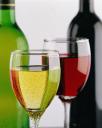In essence, it means it’s a mix. If used on labels, it usually means that the wine is based on several different grapes. However, it is a more common term in wineries where it signifies a specific mix of different grapes or wines. In Champagne, cuvée has special importance – when making ordinary champagne you strive to create the same taste year after year. This can be achieved by mixing wines from different years, and it is as important as it is difficult – the individual in charge of the cuvée for a champagne house has an enormous status.
Monthly Archives: July 2007
What is C2H5OH?
C2H5OH is the chemical form of alcohol. It can be Ethanol, or Ethyl Alcohol. The alcohol molecule consists of Carbon, Oxygen and Hydrogen.
Alcoholic beverages can be created either through fermentation or distillation. Yeast will, with a rare few exceptions, convert sugar to alcohol, carbon dioxide and energy up to about 15 percent proof. After that, the alcohol level becomes toxic to the yeast. All alcoholic beverages with more than 15 percent alcohol has been distilled or have had pure alcohol added. Wines can be mixed with alcohol that has been created through distillation of wine grapes – Port wine is an example of this.
Filed under Production
Which contains most calories – wine or beer?
The calories in wine and beer can be found in the alcohol – higher alcohol concentration means more calories. Wine therefore has more calories than beer.
Filed under Health
Why is red wine red and white wine white?
 The question might sound naive, but the answer is actually not entirely straight-forward. It is easy to think that red wines are made from blue grapes and white wine are made from green – but there is much more to the wine making process than just that.
The question might sound naive, but the answer is actually not entirely straight-forward. It is easy to think that red wines are made from blue grapes and white wine are made from green – but there is much more to the wine making process than just that.
The colour of the grape comes from its skin. There are green grapes and blue grapes, but the juice is always close to white. When making white wine, the grape is crushed, the juice extracted and then fermented into wine. When making red wine, the grape is crushed and then the juice is fermented together with the skin. The intensity of the wine will depend on how long the skin is stored together with the juice and how thick the skin of the grape is.
This means that it is fully possible to make white wine from blue grapes, but impossible to do the opposite. Champagne is a good example: In the Champagne region grows two types of blue grape (Pinot Noir and Pinot Meunier) and one type of green grape (Chardonnay). Despite this, almost all champagne is white. You simply crush the grapes, extract the juice and discard the skins. This way, the must has no colour from the skins, and the wine is white.
Filed under Production
